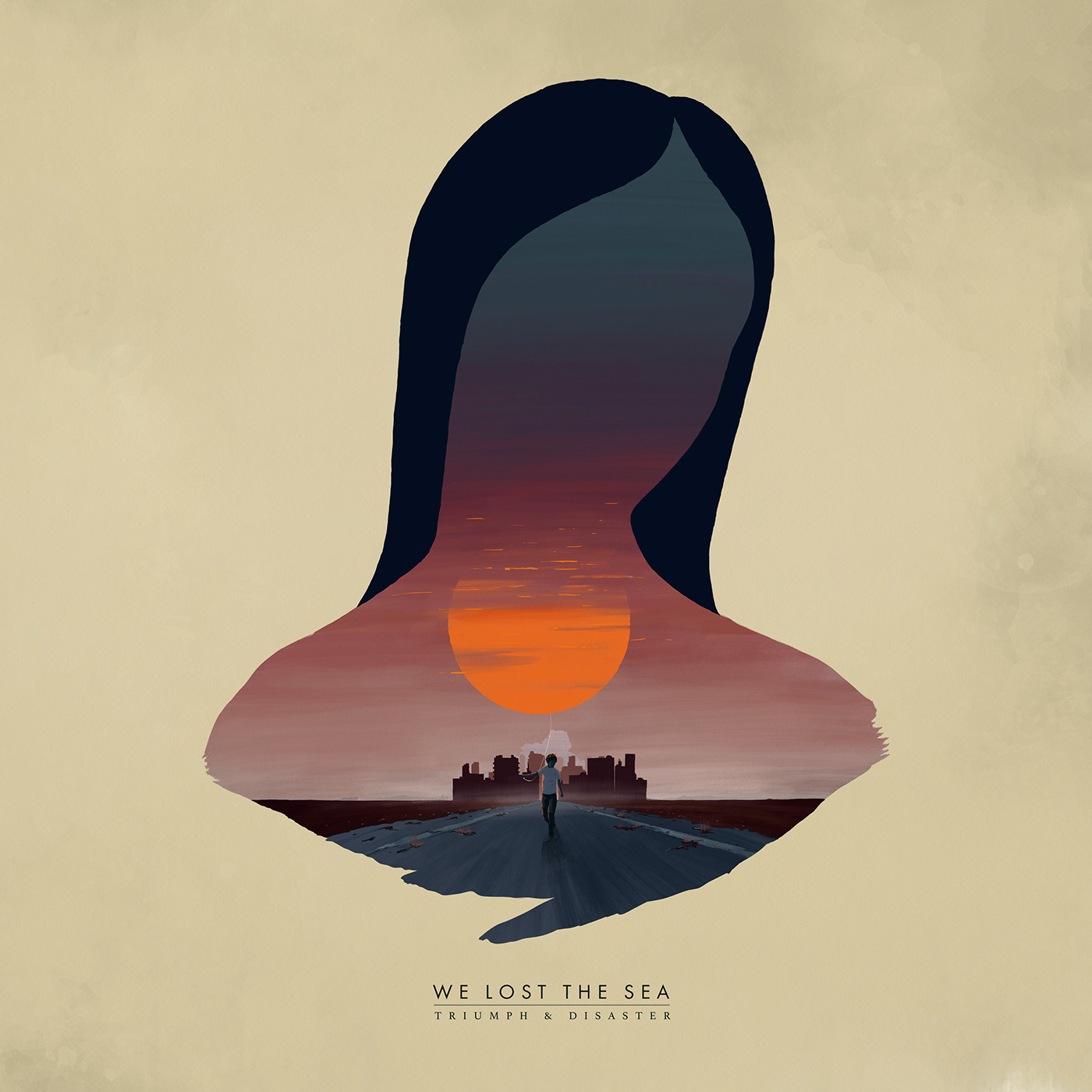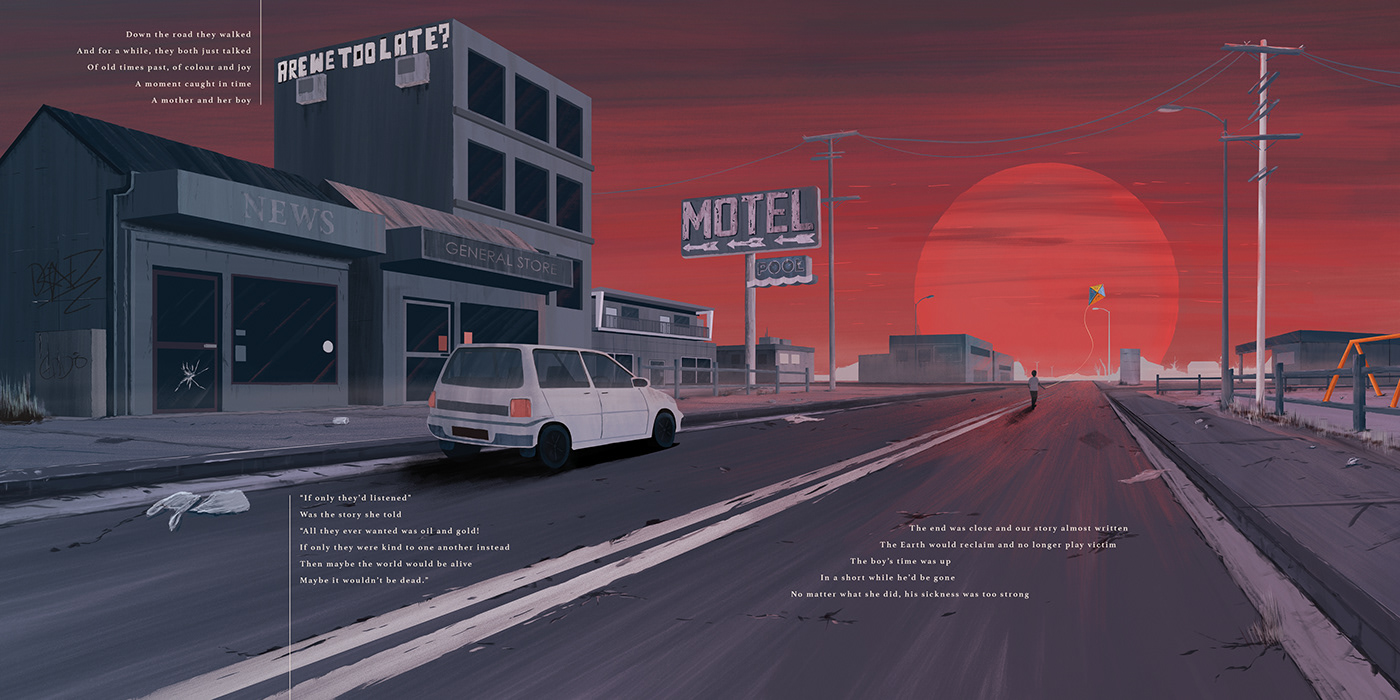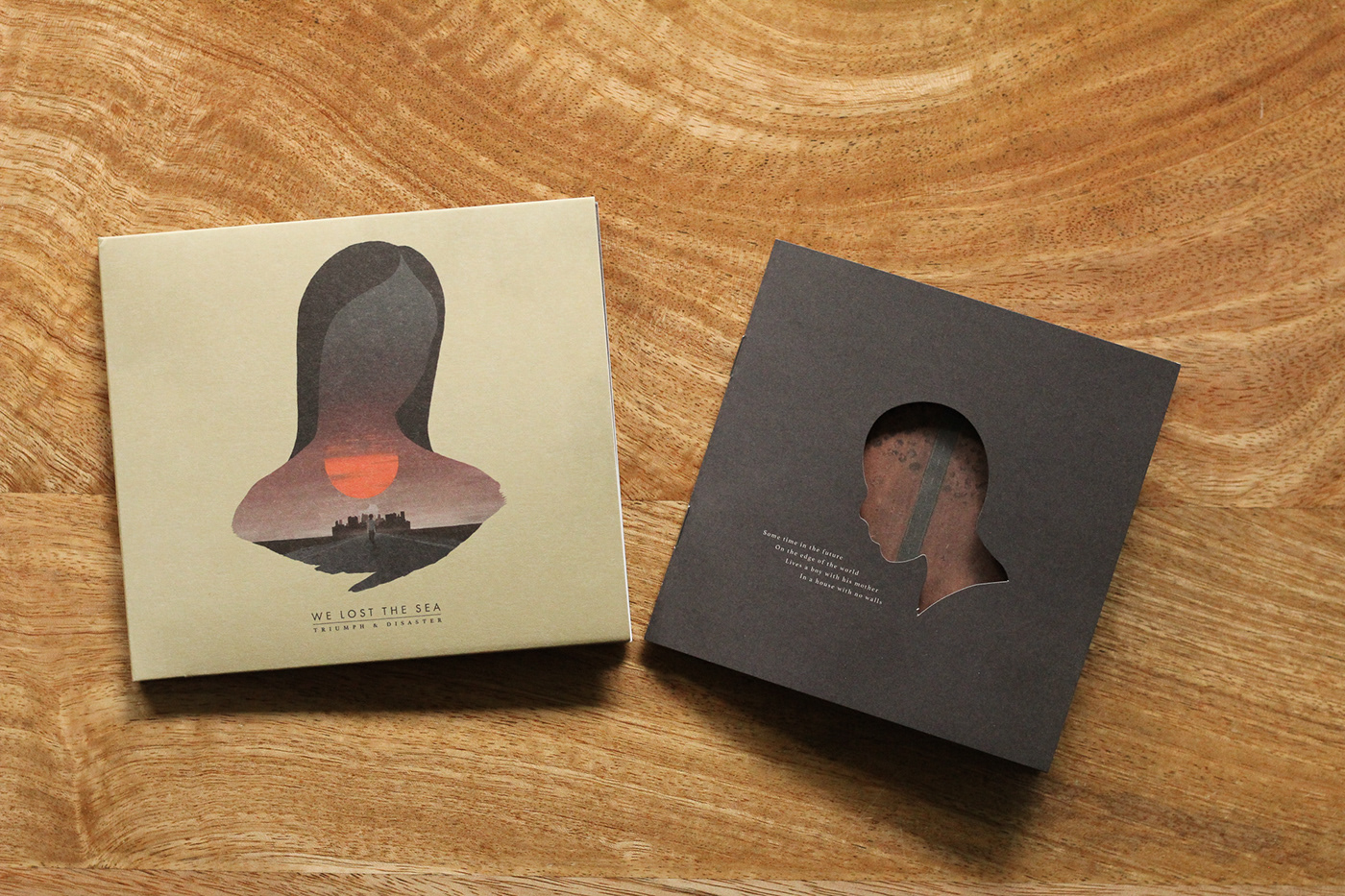


Triumph & Disaster is We Lost The Sea's fourth album and follow up to Departure Songs (2015). It is a post-apocalyptic view on the collapse of the world told like a children’s story and illustrated through the eyes of a mother and her son as they spend one last day on Earth. In this album we try to talk about themes and events such as the climate crisis, over consumption, isolation, and the loss of love and trust. It is a lament for our planet, all of us on it and the beauty we will leave behind.
The music is the narrative for the destruction and tragedy. The words and art below tell the story of love, loss and letting go.
Listen to the album here
Prints available for purchase here
Listen to the album here
Prints available for purchase here


~
Some time in the future
On the edge of the world
Lives a boy with his mother
In a house with no walls
~

~
Their garden has no flowers
The trees are all dead
The green grass is brown
The green grass is brown
While the landscape is red
“We should go for a walk and not wait ‘till the end.”
The boy smiled
“One last adventure under the sun”
“It’ll be like before, c’mon let’s have some fun.”
~

~
Hand in hand to the park they went
To play on the broken old swing set
He’d never be a spaceman, making his descent
Just the same, he flew in his seat, how high he could get!
To play on the broken old swing set
He’d never be a spaceman, making his descent
Just the same, he flew in his seat, how high he could get!
Next was a bike race, as fast as can be
Down the hill, this last ride
The joy on his face was all that she could see
She let him win
Her face beamed with pride
~

~
Not far from the shore, an old boat floated on a lake
Faded and forgotten things bumped as they passed
The captain stared out into the water, like a giant silver snake
This voyage would be his last
Faded and forgotten things bumped as they passed
The captain stared out into the water, like a giant silver snake
This voyage would be his last
~

~
Down the road they walked
And for a while, they both just talked
Of old times past, of colour and joy
A moment caught in time A mother and her boy
And for a while, they both just talked
Of old times past, of colour and joy
A moment caught in time A mother and her boy
“If only they’d listened”
Was the story she told
“All they ever wanted was oil and gold!
If only they were kind to one another instead
Then maybe the world would be alive
Maybe it wouldn’t be dead.”
Was the story she told
“All they ever wanted was oil and gold!
If only they were kind to one another instead
Then maybe the world would be alive
Maybe it wouldn’t be dead.”
The end was close and our story almost written
The Earth would reclaim and no longer play victim
The boy’s time was up
In a short while he’d be gone
No matter what she did, his sickness was too strong
The Earth would reclaim and no longer play victim
The boy’s time was up
In a short while he’d be gone
No matter what she did, his sickness was too strong
~

~
The mother wiped her tears and turned to the boy
What she saw was not despair but hope and a little joy
What she saw was not despair but hope and a little joy
“When I’m gone you can build something better
Together, you can be one.
It’s the only thing to do that hasn’t begun.
Before, we couldn’t see, but now we must,
We need love and we need to trust.”
Together, you can be one.
It’s the only thing to do that hasn’t begun.
Before, we couldn’t see, but now we must,
We need love and we need to trust.”
“Today has gone
Tomorrow’s a new
The question left to ask is not only to you”
At the end of their time under the last beautiful sun
His eyes slowly closed
His hands went numb
With tears in her eyes, she laid him down but held tight
The boy reached out and with all his might
“With all that we’ve done we should accept fate.
But what we truly should ask is -
Tomorrow’s a new
The question left to ask is not only to you”
At the end of their time under the last beautiful sun
His eyes slowly closed
His hands went numb
With tears in her eyes, she laid him down but held tight
The boy reached out and with all his might
“With all that we’ve done we should accept fate.
But what we truly should ask is -
Are we really too late?”
~















Towers
This represents the beginning and end of everything. To sum up where we’ve been and our successes and failures - our triumphs and disasters. It really represents a lot of what we’re talking about with this record and sets the tone from the first note. It’s about giant oppressive forces and feelings, the towering juggernaut of power, failure, history and death.
This represents the beginning and end of everything. To sum up where we’ve been and our successes and failures - our triumphs and disasters. It really represents a lot of what we’re talking about with this record and sets the tone from the first note. It’s about giant oppressive forces and feelings, the towering juggernaut of power, failure, history and death.
A Beautiful Collapse
This picks up at the very end of our human story. When we’ve failed for too long, and chosen to ignore science and the planet’s own desperate cries, we’ve hit the tipping point. It starts as a reflection on what was great, like a nostalgic view of our past. It then moves to an unstoppable and devastating change. Our reliance and celebration of technology and the problems that come with rapidly advancing innovation. Perhaps it's from the view of the universe who watches back in on itself as we appear and disappear as a tiny blip on the cosmic radar. Or maybe it’s from the viewpoint of a particularly nonchalant omnipotent being who watches from afar with a morbid curiosity as the last death throes of humanity shudder one last time. Destruction as a form of creation. A Beautiful Collapse.
Dust
This picks up at the very end of our human story. When we’ve failed for too long, and chosen to ignore science and the planet’s own desperate cries, we’ve hit the tipping point. It starts as a reflection on what was great, like a nostalgic view of our past. It then moves to an unstoppable and devastating change. Our reliance and celebration of technology and the problems that come with rapidly advancing innovation. Perhaps it's from the view of the universe who watches back in on itself as we appear and disappear as a tiny blip on the cosmic radar. Or maybe it’s from the viewpoint of a particularly nonchalant omnipotent being who watches from afar with a morbid curiosity as the last death throes of humanity shudder one last time. Destruction as a form of creation. A Beautiful Collapse.
Dust
A memory or a dream. A nostalgic feeling of something we’ve lost. Time passes as we breathe the dust and walk on.
Parting Ways
This is the beginning of our narrative. We meet the mother and son, and see the day to day repetition of just being able to survive. We learn that the son is dying, and the mother decides to take him out for the day. This song is a journey, it ebbs and flows and accelerates to a point that's almost out of control. And then it suddenly changes mood, and we are back to a more sombre morose contemplative moment. One that sees the mother and son both looking back on their day, and the setting sun.
Distant Shores
Is contemplative and soothing, like a mother with her sick child, calming. It's meant to give you time to emotionally digest the slab of music before it and after it and give the listener a chance to breathe. So sit back, close your eyes, and think of the water slowly crashing against the shore.
The Last Sun
This is in a lot of ways both the entire narrative and also such a small peak into a moment within our mother and son narrative. It’s both the creation of society and social structures, political, religious, it is architecture, the economy and the collapse of all of that, and the lament for it. And it is a mother holding her son as he takes his last laboured breath, the whirlwind of grief and anger and disbelief all at once, and then the quiet, as she sits and holds him and contemplates "How did this happen?" and asks a simple "Why?". It's the understanding of rest, for the son, for the mother and that it is the end for them both, and maybe that’s OK. The song ends with the mother alone at the water’s edge, not being able to comprehend why the leaders of men who knew this would happen let it happen for greed. She lost her son, for what?
Mother's Hymn
This is almost an epilogue. It’s set now, and it’s just one question. Are we too late?
Can we come back from the brink? Or is this all for nothing.
Can we come back from the brink? Or is this all for nothing.

Prints available for purchase here

We wanted to intentionally inject a message into this album through our music, art and narrative that deals with big issues and bleak themes. While the climate crisis apocalypse is possibly falling on tired ears, it is such a massive part of the ever shifting cultural zeitgeist of modern times that is hard to ignore. This album is a sad love letter about the planet, our children and their children, and hopefully, a call to arms. Instead of leaning on facts and figures we wanted to reach out and deliver our message in bleak but kind way that only art can transcend. The children’s book idea allowed us to reduce these huge topics into simpler forms, perhaps how a child would look up and view the world through their eyes.
Below is a theme exploration document that I put together to help break down these huge ideas into some kind of structure. It was used as inspiration for the flow of the album and the narrative of the story. This was made a while before we broke it down into a children's book format. Think of it like an apocalyptic Where The Wild Things Are.



Artwork has been a big part of WLTS - since the last record specifically. Each song had its own piece of art that represents the story the song is written about. It creates an extension of the music and more depth to our music. Being an instrumental band is sometimes a challenge to keep people interested and engaged.
Here are some rough initial sketches I did to try and work out what form the illustrations would take and how to tell a story that was separate from the music on the album but somehow related.
Think of it as the music is the soundtrack playing to the destruction and apocalypse happening in the distance and the story and art is the heart and personal connection to our world and a sad goodbye to the colour and joy we leave behind when we die.

I remember when it came. Everything happened at once like cacophony of events all formed to one
single point.
single point.
The oceans moved in and we moved out. Winds ripped roofs off houses and flipped cars like they were toys. Those who were already on the fringes were hit the hardest. Some people opened their doors to help but most of us boarded up the windows and hid. Even the law ran from it. You can’t pay someone enough to stand in the face of a catastrophe for too long without questioning themselves.
The towers fell where they stood. I remember standing on the bridge looking on with thousands of others watching those things come down. No one did anything else but stare for what felt like hours. Front row seat to one of the greatest and diabolic shows you’ll ever see. Fire and dust congealed with black water and debris rolling inwards, constantly, at us. I saw people stumbling through the streets, forlorn and vague, like someone just woken from a slumber and made to run. People clutching their loved ones in the middle of the road, not knowing what to do or where to go, the tears soaked into the dust on their faces.
We’d moved from the coastlines progressively over a few years. The soil became so arid and pointless, creating giant storms as its swan song. This country’s wealth and fortune pushed back to a harsher world.
I remember the warnings, everyone knew. I guess we all hoped it would get better. How were we to really know? Or at least believe the stories?
The world was thrashing and biting at us, regaining control. Its immense and volatile arms rearing and crashing down. Its angry and terrified voice spelling out our doom through the language of its own shifting environment. We pushed it too far and it pushed back.

Below is a (long) exploration of some of the pieces. I wanted the cover art to represent the mother's character and carry a feminine influence and perspective throughout. Based off that idea I then wanted the cover of the booklet to represent the son's character. The children's book idea ended up being from the mother's perspective for several reasons. The main idea was that it was as if the mother was watching over her son.
The mother represents us and the son is the planet Earth and the journey they are on represents the trails and challenges we face as a human race.




























- Art is finding more and more ways to address Earth’s impermanence and humanity’s hand in it all. Sometimes in brazenly blunt ways, sometimes with the subtlest of touches - and in your case, sometimes through the lens of a children’s book, which is pretty damn bleak when you wrap your head around it. What was the idea behind this approach?
Good question.
Art has always been apart of the social conscious for many years. Centuries. Even the Romans had to clean anti-establishment graffiti off walls, as we do to this day. It’s no surprise that when the world is facing a global conflict or even a local one, artists mobilise and draw their influence from their surrounding stimulus. I’ve just travelled through Colombia, once regarded as the most violent country on earth that is now slowly trying to transform itself to something safer and calmer and artists are at the centre of
that movement.
that movement.
Art is even more important now than ever. We have relied a lot on scientists to be the story tellers and spokespeople for our current global crisis and, unfortunately, most of them aren’t equipped to do that job as well. Also, people seem to ignore truth for their own made up version of what suits them best. So facts and figures are falling on deaf and tired ears. We need artists, musicians, journalists and creators to carry that message to people’s hearts and minds and leave a lasting impression. Real change.
Also, when people naively argue that politics don’t belong in music then they haven’t been paying attention. The two go hand in hand in most situations throughout history and will continue to do so. At least I hope so.
With instrumental music, we feel the art helps to tell our story as there are no lyrics to do that. It also extends and gives more depth to what we’re creating. We can take people on a journey and our fans can sit down and look through a booklet full of art and story to totally immerse themselves.
We chose to represent these huge themes through a children’s story to hit at the heart of the problem, as I mentioned above. A journey of a mother and her son through a dying world to say goodbye to all the colour and beauty we’re leaving behind. I want people to cry, reflect, lament and then act. Representing something actually too huge to comprehend by grounding it in something we call all relate to and hopefully leave a lasting impression.
Thank you.
Thank you.





